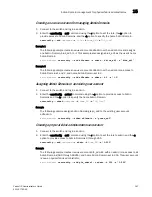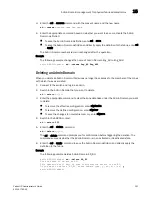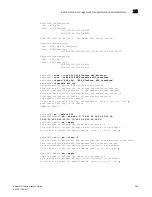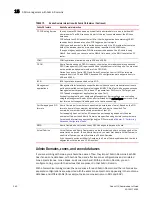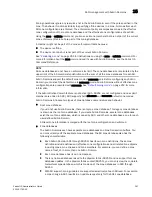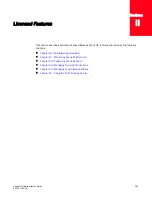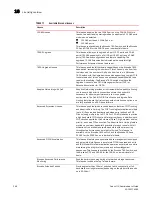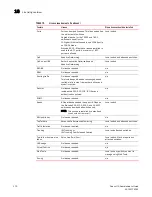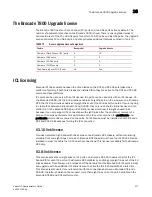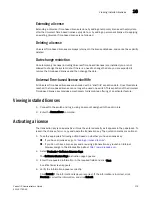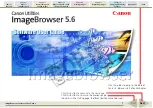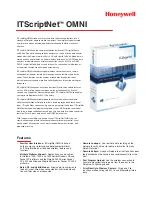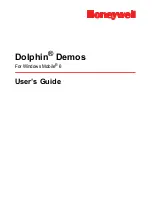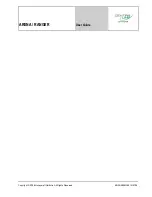
Fabric OS Administrator’s Guide
361
53-1001763-02
SAN management with Admin Domains
15
Zoning operations ignore any resources not in the Admin Domain, even if they are specified in the
zone. The behavior functions similarly to specifying offline devices in a zone. All zones from each
AD zone configuration are enforced. The enforcement policy encompasses zones in the effective
zone configuration of the root zone database and the effective zone configurations of each AD.
Using the zone
--
validate command, you can see all zone members that are not part of the current
zone enforcement table but
are
part of the zoning database.
A member might not be part of the zone enforcement table because:
•
The device is offline.
•
The device is online but is not part of the current Admin Domain.
See
“Validating a zone”
on page 251 for instructions on using the zone
--
validate command. For
more information about the zone command and its use with Admin Domains, see the
Fabric OS
Command Reference
.
NOTE
AD zone databases do not have an enforced size limit. The zone database size is calculated by the
upper limit of the AD membership definition and the sum of all the zone databases for each AD.
Admin Domains support the default zone mode of noaccess only. Before configuring any Admin
Domain, you must set the default zone to noaccess mode. Admin Domains without effective zone
configurations are presented with noaccess. See
“Default zoning mode”
on page 252 for more
information.
If the administrative domain feature is not active (AD1–AD254 are not configured and no explicit
members are added to AD0), AD0 supports both allaccess and noaccess default zone modes.
Admin Domains introduce two types of zone database nomenclature and behavior:
•
Root zone database
If you do not use Admin Domains, there is only one zone database. This legacy zone database
is known as the
root zone database
. If you create Admin Domains, several zone databases
exist: the root zone database, which is owned by AD0, and other zone databases, one for each
user-defined Admin Domain.
AD-level zone information is merged with the root zone configuration and enforced.
•
Zone databases
The Admin Domains each have separate zone databases and zone transaction buffers. You
can concurrently edit the separate zone databases. The AD zone database also has the
following characteristics:
-
Each Admin Domain (AD1 through AD254) has its own zone definitions. These zone
definitions include defined and effective zone configurations and all related zone objects
including zones, zone aliases, and zone members. For example, you can define a zone
name of test_z1 in more than one Admin Domain.
-
Each zone database has its own namespace.
-
There is no zone database linked to the physical fabric (AD255) and no support for zone
database updates. In the physical fabric context (AD255), you can only view the complete
hierarchical zone database, which is made up of the zone databases in AD0 through
AD254.
-
With AD support, zoning updates are supported selectively at each AD level. For example,
a zone change in AD1 results in an update request only for the AD1 zone database.
Summary of Contents for 53-1001763-02
Page 1: ...53 1001763 02 13 September 2010 Fabric OS Administrator s Guide Supporting Fabric OS v6 4 0 ...
Page 4: ...iv Fabric OS Administrator s Guide 53 1001763 02 ...
Page 24: ...xxiv Fabric OS Administrator s Guide 53 1001763 02 ...
Page 28: ...xxviii Fabric OS Administrator s Guide 53 1001763 02 ...
Page 32: ...xxxii Fabric OS Administrator s Guide 53 1001763 02 ...
Page 40: ...xl Fabric OS Administrator s Guide 53 1001763 02 ...
Page 42: ...2 Fabric OS Administrator s Guide 53 1001763 02 ...
Page 54: ...14 Fabric OS Administrator s Guide 53 1001763 02 High availability of daemon processes 1 ...
Page 74: ...34 Fabric OS Administrator s Guide 53 1001763 02 Basic connections 2 ...
Page 102: ...62 Fabric OS Administrator s Guide 53 1001763 02 Audit log configuration 3 ...
Page 214: ...174 Fabric OS Administrator s Guide 53 1001763 02 Management interface security 7 ...
Page 228: ...188 Fabric OS Administrator s Guide 53 1001763 02 Brocade configuration form 8 ...
Page 276: ...236 Fabric OS Administrator s Guide 53 1001763 02 Creating a logical fabric using XISLs 10 ...
Page 404: ...364 Fabric OS Administrator s Guide 53 1001763 02 ...
Page 440: ...400 Fabric OS Administrator s Guide 53 1001763 02 Performance data collection 17 ...
Page 480: ...440 Fabric OS Administrator s Guide 53 1001763 02 F_Port masterless trunking 19 ...
Page 494: ...454 Fabric OS Administrator s Guide 53 1001763 02 Buffer credit recovery 20 ...
Page 574: ...534 Fabric OS Administrator s Guide 53 1001763 02 Hexadecimal overview E ...

